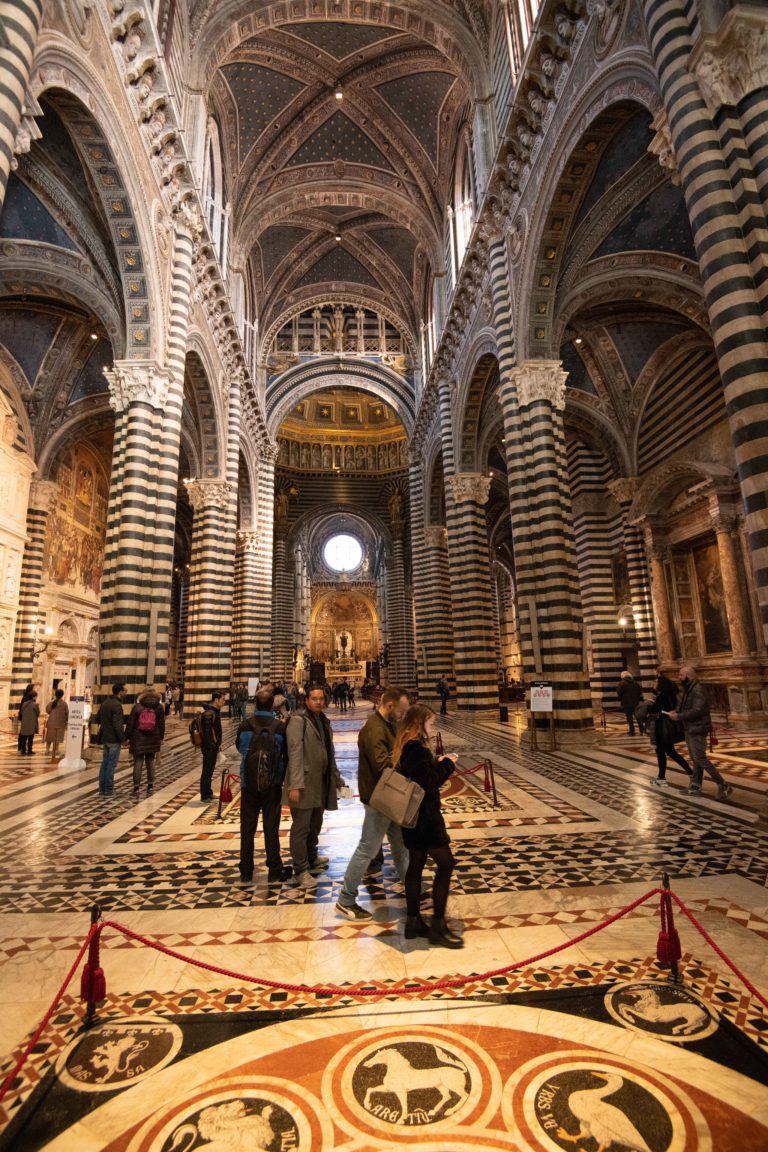the palio…
Travelling for me was never high on my list of things-to-do. My ingrained, self-created story and perception was trips were time-consuming, expensive, and never as comfortable as home. While there is a part of me that still holds to that belief, I have become far more interested in visiting different parts of the world, from Australia to South Africa, the UK, and various parts of Europe. About 10 or 12 years ago, I remember standing in downtown Rome, Italy, and marveling at the fact that I was actually standing in downtown Rome. From taking 5 years of high school Latin – I maintain to this day that Latin is one of the most useful, transferable subjects I ever studied – and from teaching about sport in ancient civilizations as a university professor, I knew a lot about the city, its history, and its impact on western culture. And yet, I never imagined I would have the resources or the privilege of actually visiting Rome; it felt both sublime and surreal to be wandering the ruins of the Colosseum, staring at the Sistine Chapel ceiling, climbing the Spanish steps, and to be marveling at the architecture and sculptures at the Trevi Fountain.
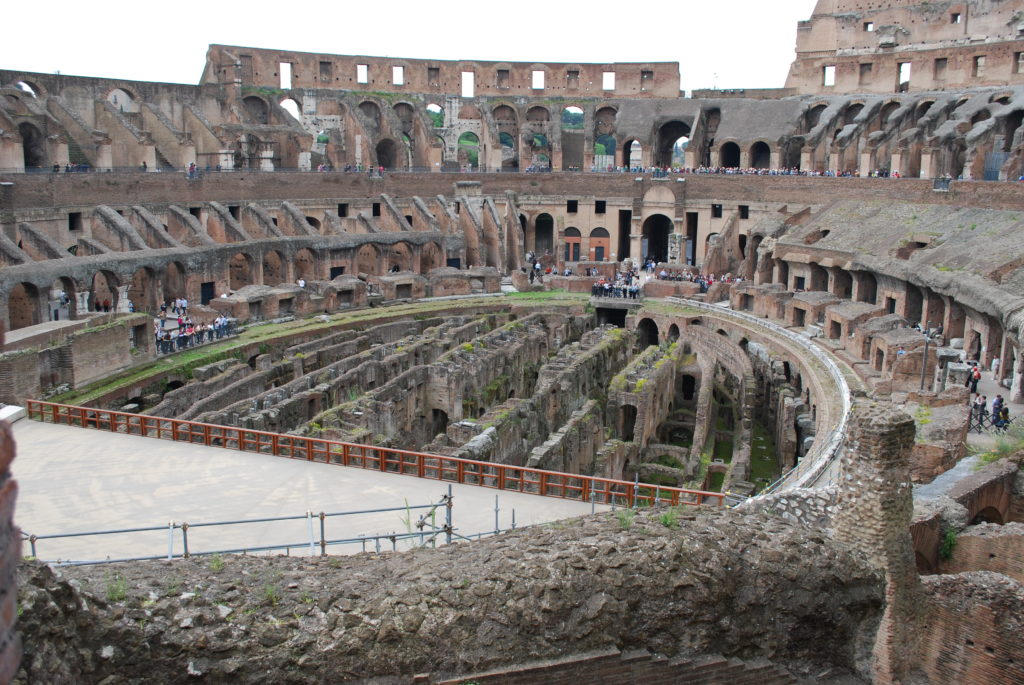
Of all the countries my wife and I have visited, I think Italy has always fascinated me. The richness of its history and the ambiance of its peoples seem to envelop me when I am there. Our very first visit was to a little commune called Pratola Peligna in the Abruzzo region of the country.
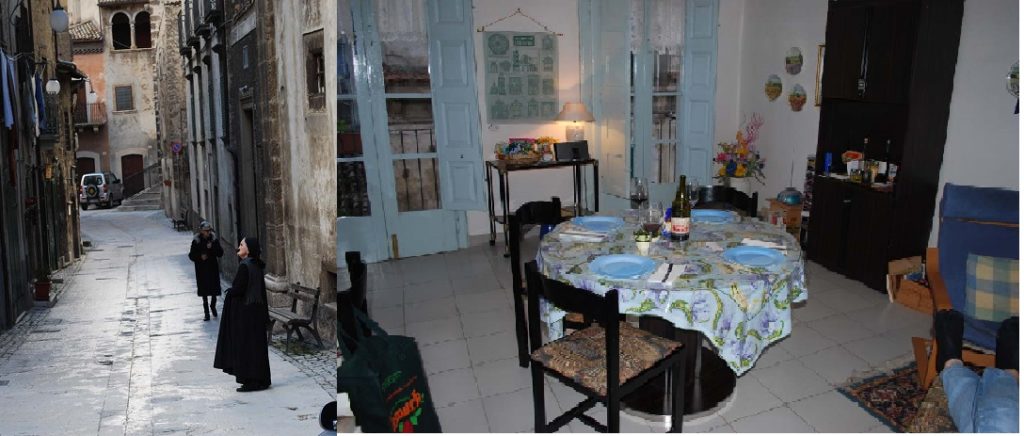
Our intention was to stay among the people in a lesser known area of Italy and it was such a rich experience. Our carefully studied, Rosetta-stone, Italian language learning was for naught; the dialect spoken in Pratola rendered our best efforts at communicating to be useless – hand-gesturing and gesticulating became our norm. And still, we were treated graciously as guests when we wandered the town streets or visited the piazza or, most bizarre to the townsfolk, when we went for our daily runs.
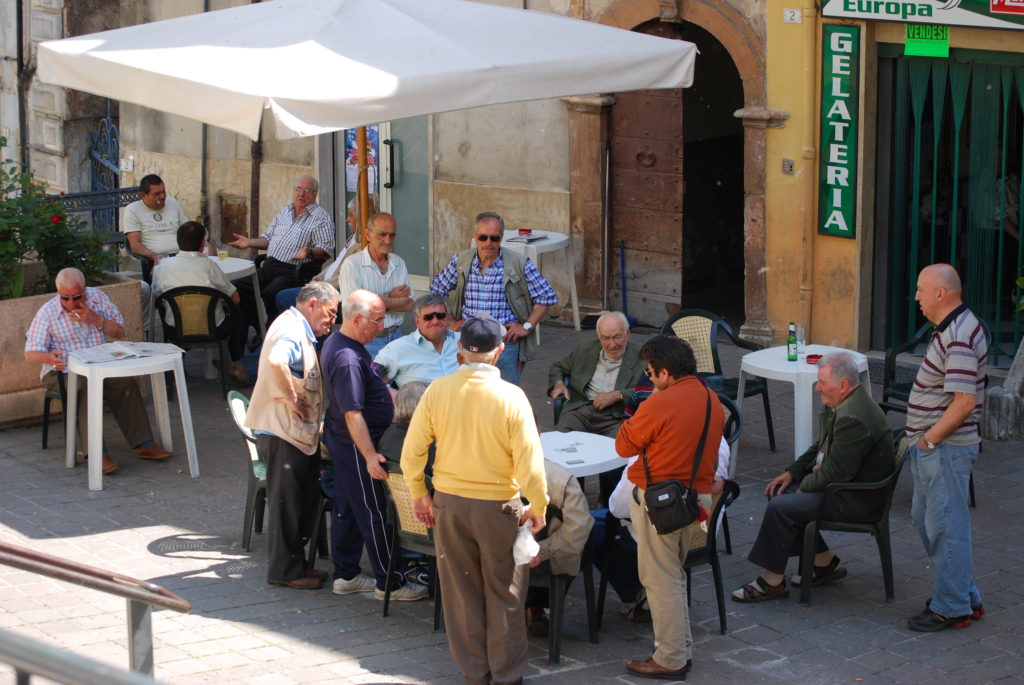
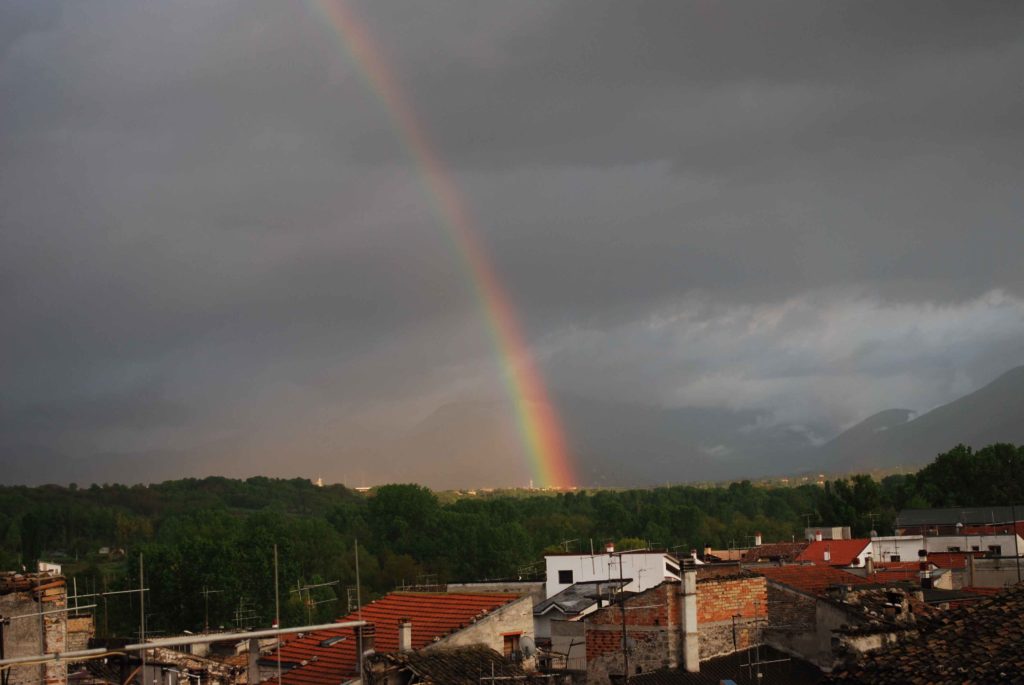
For me, nothing in any country has moved me more than standing it witness, gazing in wonder and awe at Michelangelo’s The David at the Galleria dell’Accademia in Florence, Italy.
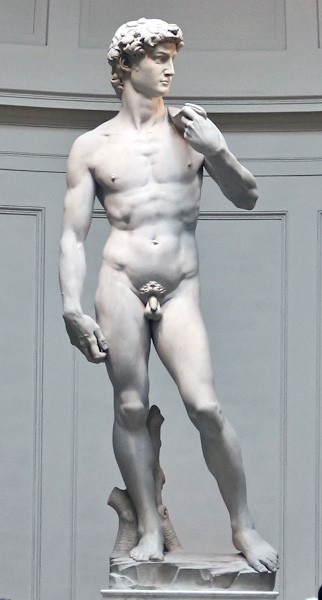
No picture or representation does justice to this magnificent work of art. I have seen the actual sculpture on 3 separate visits now and each time, just standing still in front of him has moved me to tears. That one human being could create such a rendering of humanity, in such precise, physical detail, exuding such beauty, and on such a grand scale is unfathomable and so inspirational. 500 years after its creation, having stood outdoors for decades, The David is still exquisite and even in his silent stance, he gazes and he beckons the world to gaze back.
Everywhere one travels in Italy, the country oozes and exudes history. Millennia of events, people, architecture, music, sport, art, and so much rich culture have transpired and continue to inspire and impact its people and those who choose to experience its gifts. Most recently, we had the opportunity to visit Siena, a Tuscan city of some 60,000 persons. In the James Bond 2008 spy film, Quantum of Solace, there is a now-famous opening car chase scene wherein Daniel Craig races from Lake Garda to Siena in his Aston Martin DBS V12. ‘Bond’ enters Siena, likely, through its south gate, one of some four portals built into the massive, Medieval-era wall built as a fortress around the circumference of the ancient city.
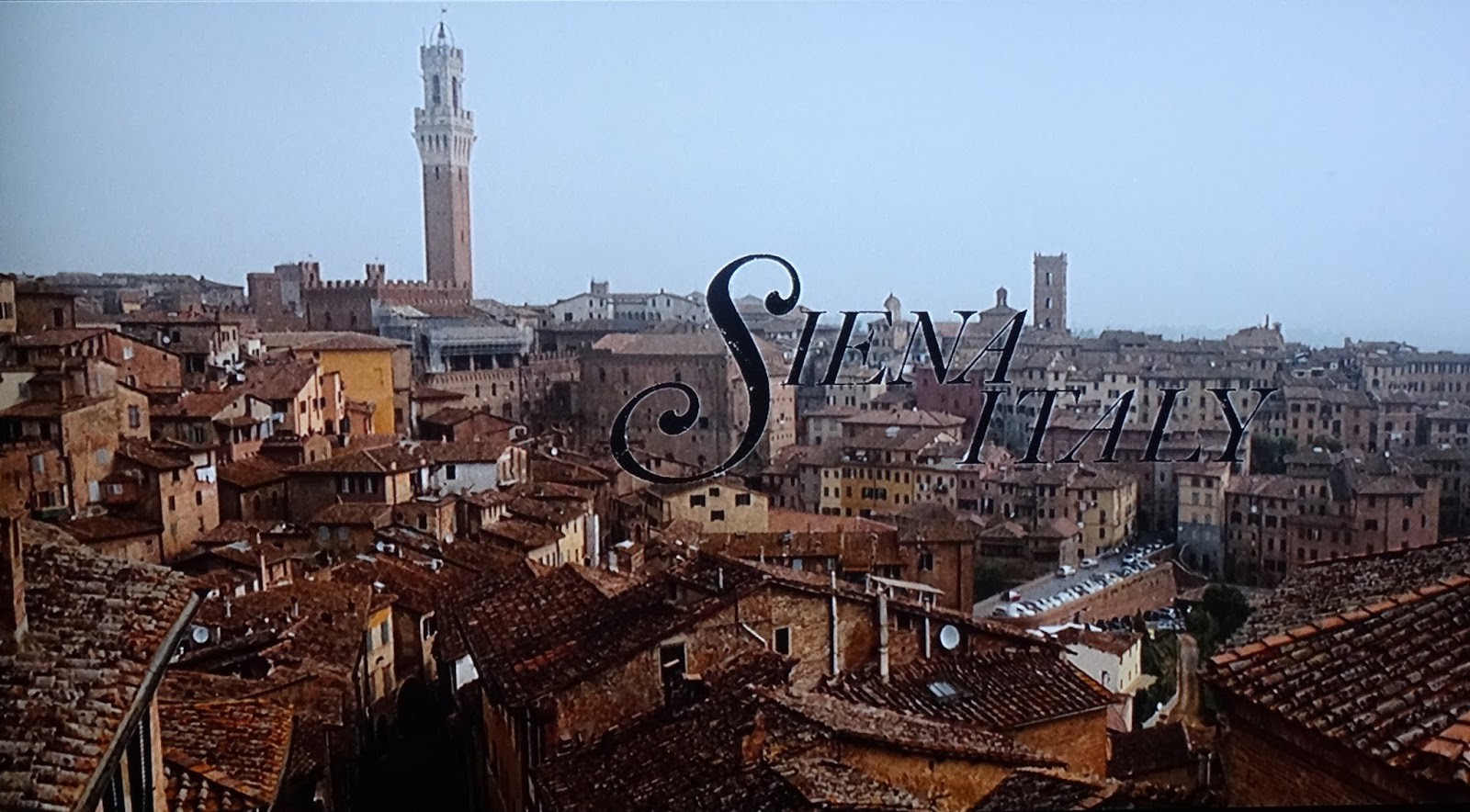
In effect, Siena presents itself as two entities defined and delimited by its wall; within its confines, the streets are narrow, traffic is restricted, and so much of the architecture of the Middle Ages remains. Going out any of its gates, the landscape changes drastically into Siena’s more contemporary growth and perfusion – one could be in almost any modern European city. We had the opportunity to rent an apartment in the core of the walled part of Siena, within minutes of the city’s famous Il Campo, the central public piazza (square) of the city. The Campo is dominated by the Torre of Mangia pictured in the images above and below.
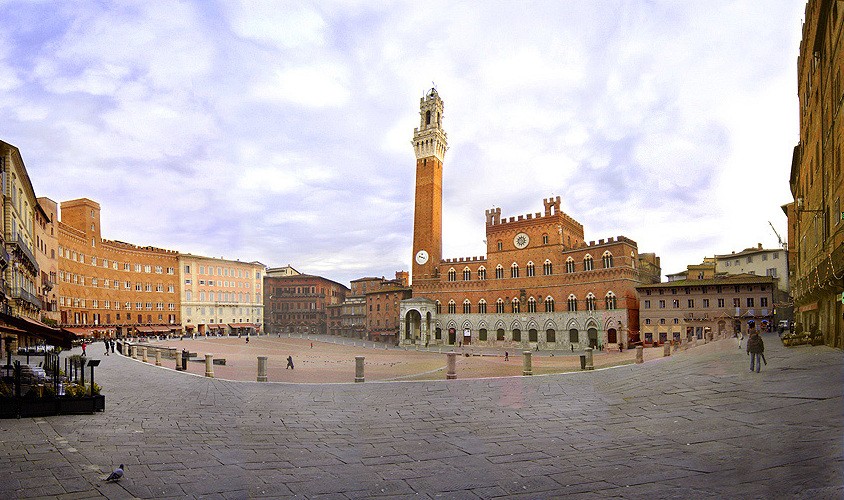
What riveted me to this square initially and throughout our stay was our guide’s explanation of the Palio, a centuries-old – perhaps even dating to the 13th century – horse race held twice each year, on 2 July and 16 August, each one in honour to/of Catholic icons. It is an event that absolutely captivates the townsfolk and is linked to so much culture, behaviour, religious belief/s, and the zeal for the race in its entirety.
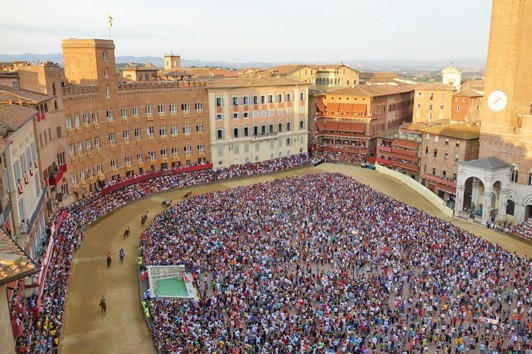
Siena is divided into 17 city wards or contrades; each contrade has its own name and symbol – caterpillar, porcupine, goose, tower, giraffe, snail, etc – and set of colours. Pageantry, celebration, tradition, rivalry, and devotion characterize each and every palio and the competing contrades. For the palio, the contrades are rivals to each other; only 10 of the contrades can be represented in one race and tha determination is made by a lottery with a great deal of fanfare. The 7 horses of the contrades that don’t make it into, say, the July palio, are automatically entered in the August one and the 3 remaining places are drawn. The actual race is 3 laps and lasts about 90 seconds. It is sport in all its glory and shortcomings, both of which extremes are established and fostered by the people involved in all aspects of the event.
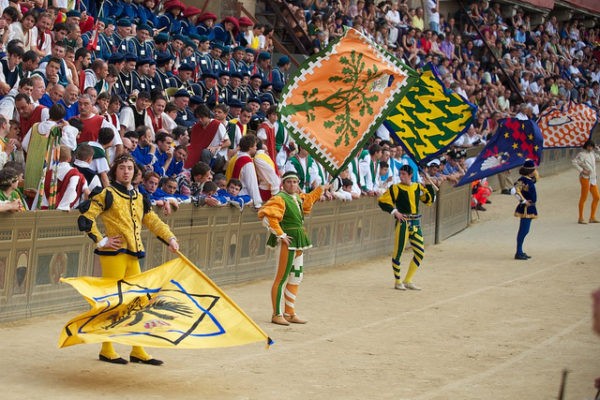
The term sport is rife with meaning/s. Some scholars believe the word is a contraction of transport. And horseracing itself is one of the oldest forms of sport known to humankind. In one of the earliest pieces of western literature, The Iliad, in Book 23, Homer described the intricacies of a chariot race. Indeed in most horseraces, riders are conveyed across – tran-sported – some kind of race course either on horse back or in some pulled conveyance. Legendary are the chariot races run in Rome’s Colosseum (and elsewhere) during the ludi or public games hosted during the Roman Empire period. During the Middle Ages, tournaments and jousts dominated the sport and pageantry, at least for the elite, of western Europe and very likely inspired Siena’s innovative adaptation to the palio format. By the Elizabethan era, the word sport came to be equated with the notion of pleasure. In Shakespeare’s King Lear, for example, blinded Gloucester laments, “as flies to wanton boys are we to the gods. They kill us for their sport” (Trivial Pursuit players might have seen this quotation on the side of the popular game box). On the surface or nominally, we play sport or at sport, a concept I discuss later in this blog.
During the 19th Century, sport was transformed and shaped by the games ethic cultivated by British public schools, spread by graduates of those schools, and propounded by widespread reading of Thomas Hughes; Tom Brown’s Schooldays. Within that 1857 novel, many of the modern notions and meanings attached to sport were described and lauded – team sport and character building; sportsmanship and fair play; masculine ideals associated with winning in sport; the enshrining of sport in schools and universities, and so forth. Throughout all of this evolution of sport, horseracing remained a preeminent sport – it has long been hailed as the sport of kings and race tracks, Queens’ plates, the Ascot, the Kentucky Derby (part of the ‘triple crown’ of the sport), and many other venues and races were developed and nurtured.
Underlining all of this very general description of sport’s growth as a concept is to note two adages that I have long held to be true about human nature and our attraction to sport. The first is, if it moves, why not race it? And its corollary, if we can race it, we can bet on it. That is, there is something magnetic about testing the mettle of speed and that allure carries with it the proclivity to wager and gamble, legally or not, on outcomes of any contest. To return to the palio, though unique to Siena and Il Campo, it shares the trappings of most sport, just exemplified and magnified by its unique setting. Watch this version of one of the 2018 races to get an idea of the actual event. One video site calls the palio, “the world’s most insane horserace” and with some, if not a great deal of truth. Most notable is the race course, a kind of flattened – but slanted toward the Campo centre – oval on one side, making the turns extremely tight at two corners; there are numerous incidences of horses and riders being seriously injured on those turns. Jockeys wear their contrade-specific colours, ride bare-back,and use whips (some say they are allowed to use those whips on other competitors). In this particular video (in the link above), there are 2 or 3 horses running without rider and in point of fact, a horse can win without its rider (called cavallo scosso) and it has happened. Finally, notice the size of the crowd and their involvement both during and after the race – clearly, they are invested in it and their enthusiasm is boisterous.
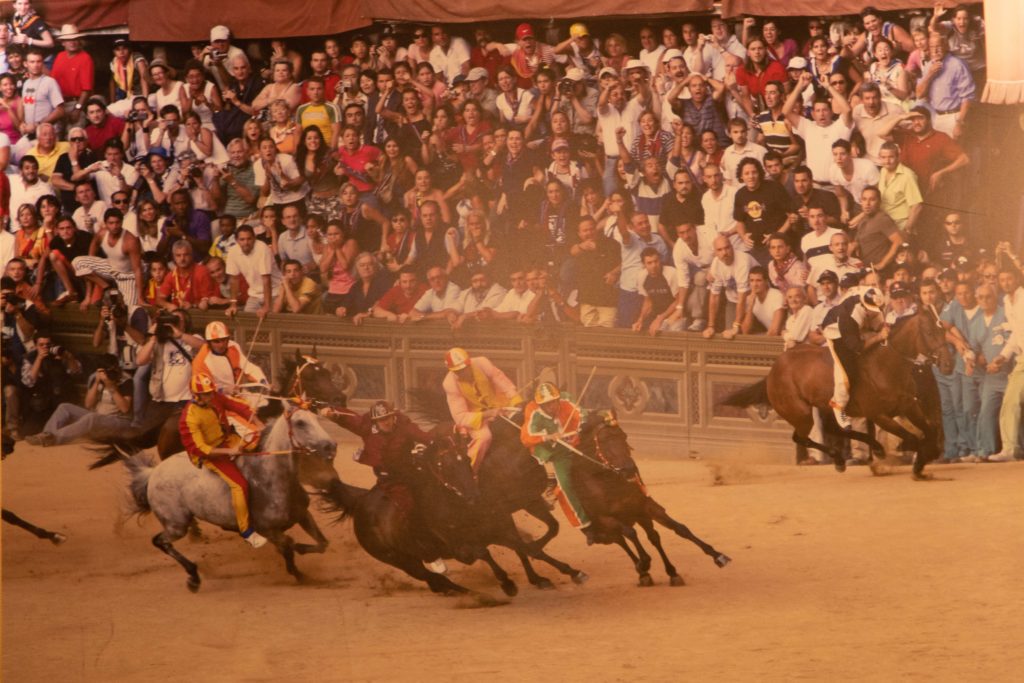
The palio on a tight turn..
Meeting rooms for each contrade are elaborate and well used. We had the privilege of visiting one of them, pictured in the two images below. Both economically and culturally, the contrades are heavily invested in the palio. Feasts precede each event and celebrations can go on for some weeks post-race, especially for the victorious contrade.
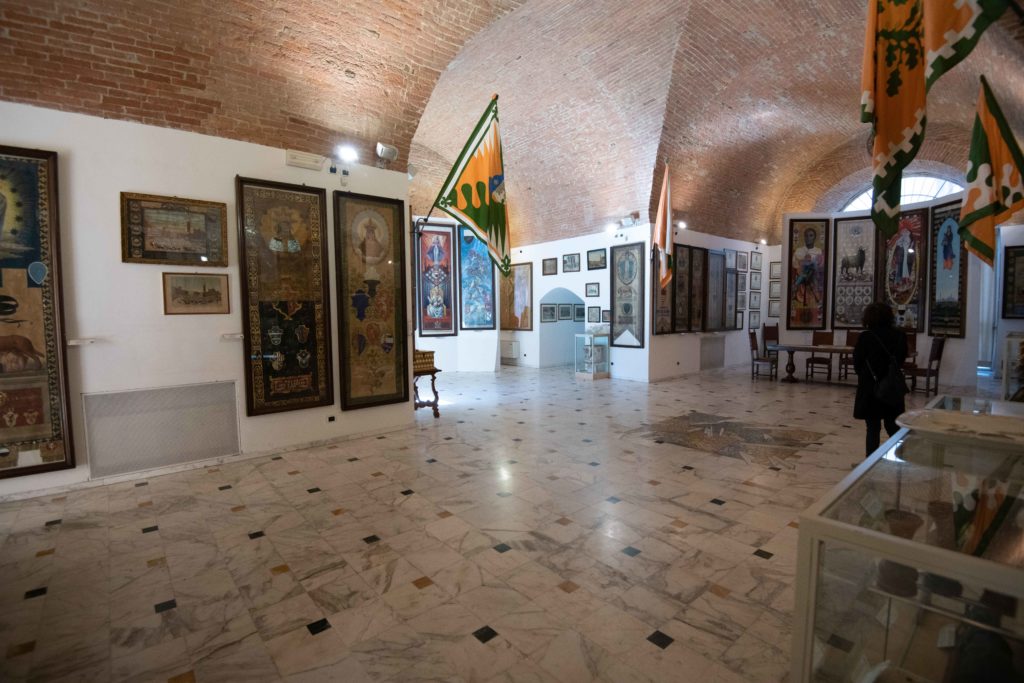
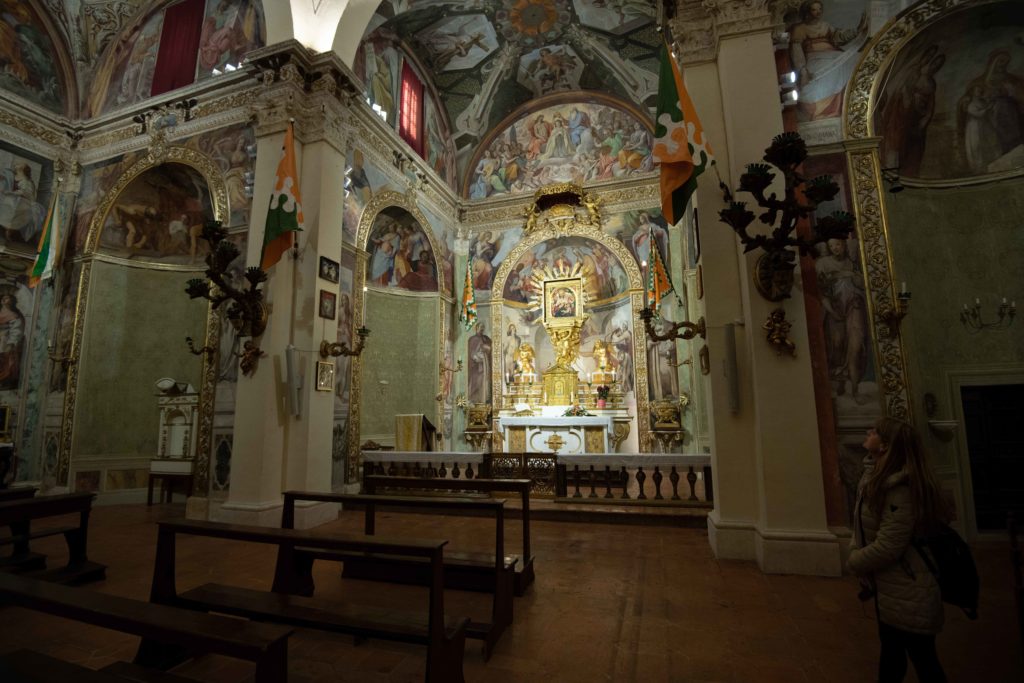
As with all sport and its attendant devotees and behaviours, excesses abound in the palio. The last or 10th horse admitted to the race-start can control his desired positioning of the other horses, often dictated by bribes from other contrades’ members. Wagering is rampant and inter-ward fighting, sometimes violence are common. I think what astounds me still is the addictive aspect of the palio and how thousands and thousands of people are centrifugally drawn both to the actual race but even more to its context, its traditions, its competitiveness, its risks, its religious tenets…the whole celebratory aspect of the event. Logically, from a human and animal safety perspective, it should not exist. And yet, it does, in fact, it thrives. Culturally, the palio-as-celebration makes more sense to me than contemporary fandom in sport. The contrades have far more meaning, temporal connotations, and just a general richness than, say, a modern sports team.
Though trained in Kinesiology with an abiding interest in sport, I have no favourite team or player in any sport. To a point, I understand what it means to be a fan of a particular team. Being a fan to the point of fanatic, that is, with unbridled passion and commitment to “my” team escapes me when player rosters change so often that “my” team is rarely the same team even within the span of a few years. In the same vein, the rampant commercialism of sport seems to over-ride the essence of sport in its full potential. Sport is played, we play sport, we watch sport being played. And yet so much of modern sport has been aggrandized into a hierarchy of excellence in performance – the higher the skill, the ‘better’ the sport. Ultimately, in my view, sport is less an activity than it is an attitude – whatever attitude we bring to sport determines how sport is played, enjoyed, participated in (directly, vicariously) etc. Sport has its conventions, rules, institutions, formats, and it can appear to be the same activity played by very young children right through to professional sport. In my view, pro sport only looks like sport; it is, in reality, a form of entertainment, designed to be produced and consumed. The attitude/s pro players, team owners, sponsors, and fans bring to that level of sport is/are very different from the attitude/s we bring to pick-up or recreational sport. And, very often, a play-ful or pure jollification in sport can get distorted or diverted or transformed when other values or behaviours are merged with the attitude/s we bring to sport.
To return to the palio then, it seems to me the 90-second actual race is almost the most minor component of the event. It is the contrades, the traditions, the meanings, the shared histories and stories, the venue, Il Campo itself, and all of the celebratory and cultural aspects that surround and infuse the palio that brings its richness as one form of human behaviour. I understand the palio more than I do most forms of commercialized sport in North America just because the palio transcends any one year’s races. I do not condone the dangers to the horses or riders in the race; significant measures have been taken in the last 4 decades to try to reduce horse and rider injuries, not enough measures for some animal activist groups. And yet I am fascinated by the richness of the palio and its interactive impact with the populace of Siena. I tumble home to all of the meanings I attach to Italy in general, and to my imagination in pondering Il Campo festooned for its palios over the centuries.
